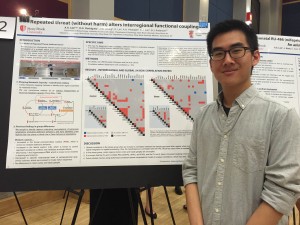Research
The laboratory of Brenda Anderson, Integrative Neuroscience, Stony Brook University
The laboratory of Brenda Anderson is interested in understanding how experience shapes the brain and behavior. In the past, we used voluntary and forced exercise in rats to model the effects of exercise in humans. We have also used corticosterone injections to mimic the effects of stress. The lab designs housing environments to test the relationship between housing parameters, behavior and neural plasticity.
More recently, we have developed a novel living environment for rats that allows us to systemically manipulate environmental factors that produce stress, and test for stress-related behavioral and neural adaptations. This environment has allowed us to test the effects of psychological stress by repeatedly presenting threats without harm. Repeated unpredictable threats produce a pattern of adaptations that parallels the symptoms of PTSD without giving a traumatic event. We are currently studying whether these environmental conditions play a role in producing vulnerability to PTSD. To learn more, watch the video in the sidebar on the right –>

The lab designs housing environments to test the relationship between housing parameters, behavior and neural plasticity.
To achieve our goals, the lab integrates three general approaches: behavioral analysis, quantitative anatomy and quantitative histochemistry.
Behavioral approaches are used to establish effects of stress and exercise on subsequent behavior in rats. For example, to test whether exercise or stress affect memory, we use the Barnes maze, Y-maze or the radial arm maze. Using the Barnes maze and the Y-maze we have tested whether the stress-related hormone corticosterone impairs spatial memory (Coburn-Litvak et al., 2003), and more recently we have shown that threats without harm impair memory when tested in basal test conditions, but not when tested in high stress conditions.
We have also tested whether corticosterone administered over long periods or repeated threat exposure affects anxiety and anhedonia (Gorby et al., in preparation; Kim, submitted). We are currently developing a toolkit that will allow us to test numerous behavioral features of anxiety.

Serial electron micrographs used for synapse counting.
Quantitative anatomical analyses are used to determine whether or not exercise, stress-related hormones or stress have an influence on capillary density, tissue volume and synaptic numbers in the brain. All of these variables would be expected to influence brain function and vulnerability. For example, we have shown that two-month administration of the stress-related hormone corticosterone (40 mg/kg) causes neuropil volume reduction and synapse loss in hippocampal area CA3 (Tata et al., 2006).
Cytochrome oxidase histochemistry provides a measure of metabolic capacity. When neuronal activity is increased or decreased, cytochrome oxidase is up/down regulated. Therefore, this histochemical stain can be used to identify areas activated by experience or a task.
Our findings have implications for the impact that lifestyle choices have on brain development, brain aging, and behavioral reactions to stimuli.

Andrew Lee presenting at the Spring 2015 URECA conference.






